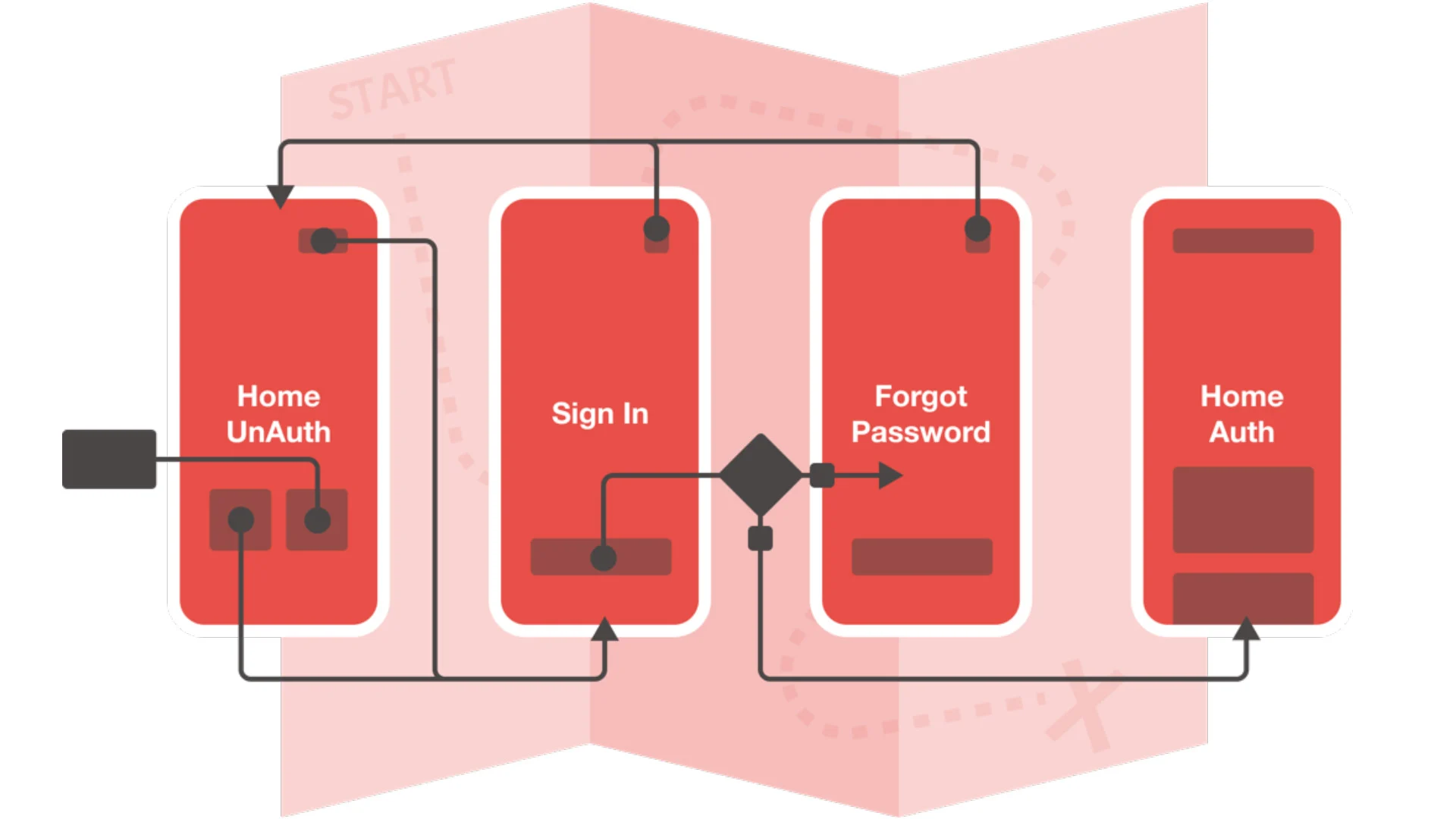Published by
Raina Probst, Carla Salcedo, and Tyler Robb explore 10 expert use cases and 8 key benefits for any product-led organization.
How can you see the impact of every change you’re considering for your digital product before you build it?
We all know that Design systems tell a visual story of your product, architecture documents tell a technical story, test plans tell a stability story, and analytics tell a behavior story. But what can tell a clear and complete story of all users’ experiences? A Product Map is the answer.
Product maps are a multi-dimensional 10,000-foot view of every screen and interaction in your digital ecosystem. Not just flows and journeys, but every outcome, edge case, and potential experience for customers or users of any kind. With it, you can forecast how a seemingly simple change may impact the entire product, even screens and flows your team typically doesn’t touch. You’ll catch bugs you didn’t realize were lurking and estimate the full scope of work that changes might lead to.
Much like a roadmap, a Product Map is a foundational point of reference that can benefit internal and external stakeholders alike. As your digital ecosystem becomes more complex, it’s increasingly difficult for anyone to see every impact of new features and changes – whether they’re a marketing manager, CTO, or the QA and user experience team. A Product Map is a one source of truth document that reveals the full picture of the product in a way that every stakeholder can understand.
From our expert perspective, here are 10 instances where we know we wouldn’t want to be caught without a map.
- When big team changes are on the horizon – This could be new internal teams, new partners, or even team blending from organizational changes. Also, when you’re shifting to or from nearshore or offshore development teams or partners. Don’t risk losing historical knowledge that’s locked away in someone’s head.
- When embarking on a massive overhaul of a feature/section – Big changes can feel scary. The effort is unknown at first and the scope can feel ever-changing. A Product Map can be an invaluable tool to bring extra clarity and nail down exactly what the future will hold. Every kind of stakeholder can work from the same shared foundation and collaborate on everything from the happiest path to the smallest error state. The best part? A Product Map can drive a new level of quality for QA teams. From end-to-end, behaviors are clear and expected from the start.
- When replatforming or “cleaning up” an existing digital product – Replatforming or adding a new third-party tool could have broad and complex impacts across your experience. In addition, with mature products the need to sunset legacy systems that are no longer being used can arise.
- When rebranding or redesigning screens — Are you launching a full rebrand or updating any core components of your experience? The Product Map helps you see how often you’ve used logos, icons, and other visual devices in your work to understand the depth of changing your visuals (i.e., visual design guidelines, brand guidelines).
- When it’s time to develop new code for an existing digital product – Is your development team likely to rearchitect a portion of your navigation? Are there areas where code can be re-used to minimize level of effort? A Product Map ensures greater quality when QAs are testing the product so that they have something to refer to for what should be happening in a digital experience.
- When software changes hands with mergers & acquisitions – As new product owners or executives come into the picture, oftentimes the digital product undergoes some major changes. Having a Product Map before you purchase a product could help you understand things like API calls, dependency driven displays, business rules and logic.
- When you are moving into new geographic regions or new business units are emerging – Anytime you plan to use one digital product to help you “go faster” or create other versions or varieties of the same product, this tool could come in quite handy. For example, a Product Map can help you understand where you will need to account for legal requirements when entering a new country or market or where to account for regional preferences for screen density among users.
- When building long-term roadmaps for your digital product – To fully understand the possibilities for the future or as a tool to identify opportunities to enhance your existing customer touchpoints at various stages in a customer lifecycle.
- When you need executive buy-in on a new experience, feature, or interaction – This tool can be invaluable to succinctly and comprehensively explain impact and gain buy-in from those that aren’t as close to an overall digital experience. Really, it’s helpful for any stakeholder to digest the massiveness of a mature product and also can illustrate the growth, balance and robustness of newer products.
- When you are seeking to deliver on users’ unmet needs – A holistic at-a-glance view in one central location allows for precise mapping of interactions and displays any given dependencies. From 10,000 feet in the air down to the minutia, this flexible and living tool outperforms more traditional documentation that imposes limits and removes rich context. Start by connecting logic together, translate this to preliminary designs, and pitch for consensus with approvals. Next, replace low-fidelity wireframes with high-fidelity documentation for a responsible way to manage new features or enhancements.
The benefits are for everyone.
When you think about it, there’s really no one person associated with a digital product team who couldn’t benefit from a Product Map. A Product Map can help ensure quality and efficiency in the continuous design and development process for mature products as well. Although the effort required to create it may be substantial, the benefits of completing it will greatly surpass the initial effort. We all know software is never actually done – let’s review the benefits that a Product Map can provide any well-oiled digital product team.
- Greater quality of your digital products
- Prevent costly mistakes over the life of the product as new features or enhancements are implemented
- Better metrics/measurement planning and reporting
- Better scenario-planning for teams
- Greater team collaboration and alignment, both internally and with partners
- Centralizes critical product knowledge in a form that can grow with your product
- Ensures customers/users can move freely between products in your ecosystem
- Helps achieve shared meaning quickly among teams
Each of these benefits contribute to providing one key thing for any successful digital product team. Does your team have a one-stop foolproof place to document everything about your digital product experience? A Product Map is a single source of truth that everyone on the team can look to for any and all decisions.
Isn’t this the same thing as a prototype?
Our answer is a resounding no. Prototypes are definitely a useful tool in the toolkit and we leverage them for their strengths and benefits as well. When interacting with users or customers, a prototype can be a useful means of demonstrating or dissecting one complicated interaction point within a digital experience. They are great for gathering user feedback before you create any code. But what a prototype can’t do is demonstrate all of the real dimensions that exist within a complex digital product experience. Product Maps can bring together multiple interaction points all into one nice view. They map screens, actions, conditions, pathways, and most importantly, outcomes. All in one nice tidy place.
Isn’t a product map hard to maintain?
All too often, documents that are owned and maintained by a single part of a team quickly get out of date and lose their usefulness. With all stakeholders benefitting from a product map, integrating its upkeep into the design and build process gets widespread support. Teams can continuously evolve it: adding to it for a new experience concept, updating it with new designs as part of the design sign off, building from it as map as a development resource, referring to it in test planning, and using it as a reporting visual that corresponds to the data.
It’s time to tidy up.
Hopefully, by this point, the value of Product Maps is clear. It’s a map, playbook, roadmap, prototype, vision document, and quality checkpoint all rolled into one nice, tidy package. Is it time for your team to get organized and get to Product Mapping? The task may seem daunting, but don’t worry, we’re always here to help.
The experience experts at Bottle Rocket are specialists in creating effective, efficient, memorable experiences for some of the world’s most well-known brands. We’ve learned a thing or two over our 15 years and have developed many best practices that our internal teams and many clients use each day. Product Maps are just one example of how we help product teams in companies of all shapes and sizes ensure they are getting the most from their digital product and that users keep coming back for more.




